| |
|
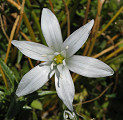 | |
| MaltaWildPlants.com by Stephen Mifsud |

|
| |
|
|
 |  |  |  |
| External Links: |
|
Senecio leucanthemifolius (Coastal Ragwort) |
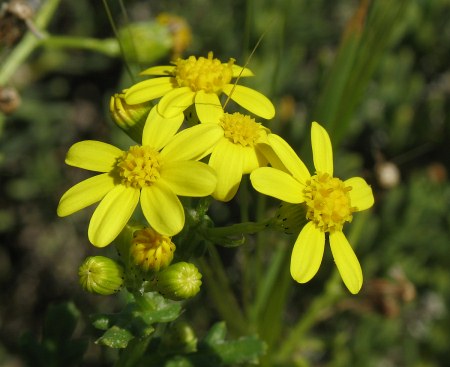
Senecio leucanthemifolius (ASTERACEAE.)
Images for this profile are taken from the Maltese Islands after year 2000. |
|
| Nomenclature |
Species name : | Senecio leucanthemifolius Poir. | Authority : | Jean Louis Marie Poiret, France, (1755 - 1834) | Synonyms :
(basionym or principal syn.) |
|
Plant Family : | Asteraceae Bercht. & J.Presl (= Compositae )
(Daisy or Sunflower Family) | English name(s) : | Coastal Ragwort | Maltese name(s) : | Kromb Tax-Xatt | Status for Malta : | Indigenous. Present on the Maltese islands before man | Name Derivation : |
Senecio: from senex meaning old man for the possession of hairy parts in flower bracts, becoming more evident when fruiting. (Latin origin ); 2 = from "Senex" meaning an old man referring to hairy parts of flowers, stalks and seeds (Latin).
leucanthemifolius: Having leaves similar to plants in the genus Leucanthemum - the Oxe-eye daisies. (Latin origin ); 2 = Having leaves resembling species of the Genus Leucanthemum - the Oxe-eye daisies. (Latin).
| Remarks : | |
|
| Morphology and structure |
PLANT STRUCTURE: |
Character | Growth Form | Branching | Surface |
Description | | | |
General
Picture |  |  |  |
|
LEAVES: |
Character | Arrangement | Attachment | Venation |
Description | | | |
General
Picture |  |  |  |
| |
Character | Leaf Shape | Leaf Margin | Remarks |
Description | | | Succulent: A plant having fleshy stems or leaves, often adapted to conserve water in an extremely dry habitat (xeric habitat). |
General
Picture |  |  |  |
|
FLOWERS: |
Character | Colour | Basic Flower Type | No. of Petals | No. of Sepals |
Description | Yellow | | 5-8 Referring to the ray florets. | 24-36 Referring to the phyllaries of the involucre. |
General
Picture | | 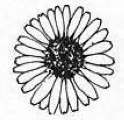 |  |  |
| |
Character | Inflorescence | Description | Ovary | Stamens |
Description | | Cylindrical green involucre composed of 3 (or 4) layers of narrow phyllaries of which the lower 2 having a black tip. The capitulum (flower head) consists of few yellow ray florets ('petals') that are well spaced from each other and a central small disk of tiny florets of the same colour as the 'petals'. | | |
General
Picture | 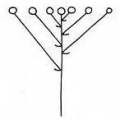 |  |  | 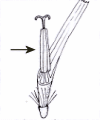 |
| |
Character | Scent | Average Flower Size | Pollen Colour | Other Notes |
Description | Faint sweet smell | 15-25mm x 8 mm (diameter x involucral length). | Yellow | - |
|
SEEDS: |
Character | No. Per Fruit | Shape | Size | Colour |
Description | 40-60 | | 2-3mm (excluding pappus). | Light brown Seeds covered with very fine, silvery-white, appressed hairs. |
General
Picture |  |  |  |  |
|
FRUIT AND OTHER BOTANICAL DATA: |
Character | Fruit Type | Colour of Fruit | Subterranean Parts | Other Notes |
Description | | White (Referring to the pappi of the collective fruit head). | | - |
General
Picture | 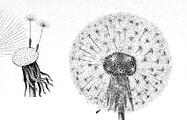 |  |  |  |
|
|
| Plant description and characters | |
Life Cycle: | Annual. |
Growth Form: | THEROPHYTE (annual plants, herbaceous) |
Habitat: | Garigue and rocky sites near the coast |
Frequency: | Frequent |
Localities in Malta: | Locally frequent in Gozo but rather rare in Malta. Found abundantly at Dwejra, Xlendi and Ta' Cenc. |
Plant Height: | 10-30cm. |
| Dec-Apr |
Protection in Malta: | Not legally protected till the last update of this website (2/Mar/2022) |
Red List 1989: | Threatened status for the Maltese Islands and has been listed in the Red Data Book (1st ed.) |
Poison: | |
An erect, low growing, herbaceous plant that forms branches from its basal part. It is often found as a glabrous plant but some specimen may have sparsely floccose hairs.
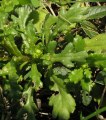 It forms many fleshy (succulent) leaves that have deep, broad lobes often arranged in an opposite arrangement. The breadth and depth of the lobes is irregular from leaf to leaf. Leaf outline is furthermore irregularly, bluntly dentate, especially at the terminal part of leaves or in cauline leaves. Leaves are sessile (except basal ones), alternate and have small, reduced auricles (flaps) at the base which goes approximately half-way around the stem perimeter.
It forms many fleshy (succulent) leaves that have deep, broad lobes often arranged in an opposite arrangement. The breadth and depth of the lobes is irregular from leaf to leaf. Leaf outline is furthermore irregularly, bluntly dentate, especially at the terminal part of leaves or in cauline leaves. Leaves are sessile (except basal ones), alternate and have small, reduced auricles (flaps) at the base which goes approximately half-way around the stem perimeter.
The inflorescence is a corymb-like one with few (3-7) flowers that have stalks coming from a common point, or sometimes, from the stalk of another 'parent' flower. The flowering stalks which are about 15-20mm long, are erect and so the plant does not form drooping flowers as in Senecio vulgaris.
The flowers consists of a cup-shaped involucre made up of a group of green, narrow phyllaries (involucral bracts). There are 3 or 4 rows of phyllaries and those forming the lower 2 rows are shorter (2-3mm), triangular in shape and have a black pointed tip. The terminal row is composed of phyllaries that are linear-oblong in shape, compact and about 6-7mm long.
The involucre supports 5 to 8 (sometimes more), bright yellow, ray florets or 'petals' situated around a central disk of disk florets. The ray florets (also known as ligules) are the best distinguishing feature to identify this plant from Senecio vulgaris and Senecio pygmaeus which both have a rather similar foliage and growth form but they lack ligules completely. The diameter of the capitulum varies between 15-25mm. Disk florets have a 5-lobed tubular corolla from which the style protrudes out by 1-2mm. 5 fused anthers are arranged as a collar around the style and produce yolk-yellow pollen. Ray florets and disk florets are concolorous (of same colour).
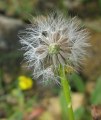 Both types of florets can be fertilised to form a single-seeded fruit known as an achene. The achenes are linear in shape, 2-2.5mm long, greyish brown in colour and have longitudinal ribs at which tiny, appressed, white hair is present. At the terminal part of the achene is found a simple, beakless pappus made of whorls of bristles that are 3-4mm long. Roughly, there are about 40-60 achenes per head collectively forming what looks as a white ball of bristles, about 2cm across. When mature seeds get loose and disperse away by wind.
Both types of florets can be fertilised to form a single-seeded fruit known as an achene. The achenes are linear in shape, 2-2.5mm long, greyish brown in colour and have longitudinal ribs at which tiny, appressed, white hair is present. At the terminal part of the achene is found a simple, beakless pappus made of whorls of bristles that are 3-4mm long. Roughly, there are about 40-60 achenes per head collectively forming what looks as a white ball of bristles, about 2cm across. When mature seeds get loose and disperse away by wind.
|
|
| Information, uses and other details |
Nativity and distribution
The plant comes presumably from Central-or Southern Russia and has spread only in the course of last century to Central-Europe; is spreading towards the West and North. [WWW-21] On the other hand, reference [383] gives the Mediterranean region as the origin. The species is fairly widely distributed in the western and central Mediterranean region and mainly in coastal regions, also occurring in southern Portugal. It was originally described from Algeria (North Africa) [50]
Possible causes of morphological variation in an endemic Moroccan groundsel (Senecio leucanthemifolius var. casablancae): evidence from chloroplast DNA and random amplified polymorphic DNA markers
Genetic variation was assessed in Senecio leucanthemifolius var. casablancae (Compositae), a Moroccan Atlantic coast endemic, in order to examine possible causes of atypical leaf morphology in three populations south of the known range. Evidence for introgression from S. glaucus ssp. coronopifolius and/or divergence was investigated with molecular markers. Both random amplified polymorphic DNA (RAPD) and chloroplast (cp) DNA restriction fragment length polymorphism (RFLP) differentiated the species well. Some evidence that hybridization may have occurred between the two species was provided by cpDNA markers. However, biparentally inherited RAPD markers failed to provide any support for the hypothesis that intermediate leaf morphologies in atypical populations arose through hybridization. Consequently, they are most likely to have arisen via divergence caused by drift and/or selection. Genetic distances among populations of S. leucanthemifolius were significant in all but one case. Isolation by distance was indicated by a significant positive correlation between genetic and geographical distances (r = 0.68, P = 0.01, Mantel test). These results suggest that long-distance achene dispersal is rare, despite the presence of a well-developed pappus. The observed loss of pappus at achene maturity may explain this unexpected result. Due to the morphological distinction of var. casablancae from other varieties of S. leucanthemifolius, we suggest elevation to species rank and treatment of the atypical material at infraspecific rank. [385]
In-vitro antiproliferative effects on human tumour cell lines of extracts and jacaranone from Senecio leucanthemifolius
We have studied the cytotoxic activity of extracts and jacaranone from Senecio leucanthemifolius Poiret. Extracts from S. leucanthemifolius were able to inhibit the in-vitro proliferation of a series of human tumour cell lines. The dichloromethane extract demonstrated effective cytotoxic activity with an IC50 of 20.1 g mL-1 on the large cell carcinoma cell line COR-L23. The ethyl acetate extract showed an IC50 value of 5.0 g mL-1 and the butanol extract an IC50 value of 6.4 g mL-1 on the same cell line. A major active constituent of the dichloromethane extract was shown to be jacaranone, which was demonstrated to have a very strong activity against all of the tumour cell lines with IC50 values between 2.86 and 3.85 g mL-1, although it did not account for all the activity observed. Constituents of S. leucanthemifolius extracts were identified by GC/MS analysis and NMR. [386]
Toxicity
One study that mentions 2 toxic alkaloids isolated from Senecio leucanthemifolius was found. The abstract reads that 2 pyrrolizidine alkaloids were isolated from Senecio leucanthemifolius and six from Senecio rodriguezii of which their structures were determined by spectroscopic methods. The toxins are .Integerrimine . Senecionine . Seneciphylline . Seneciphyllinine (acetylseneciphylline) . Senkirkine and . Acetylsenkirkine but the abstract did not mention which two were specifically derived from Senecio leucanthemifolius. [384]. Apart from this, one has to bear in mind hat this species belongs to a genus that contains a number of plants with a cumulative poisonous effect on the liver [65].
Variability
This is a rather variable plant and several synonyms and varieties has been described. The list below gives most of the varieties found for Senecio leucanthemifolius:
- S. leucanthemifolius var. fradinii
- S. leucanthemifolius var. leucanthemifolius
- S. leucanthemifolius var. major
- S. leucanthemifolius var. pectinatus
- S. leucanthemifolius var. vernalis
- S. leucanthemifolius var. vernus
The list of synonyms is longer and the most important ones can be found in the nomenclature part of this profile. [SM]
Personal Observations
Populations in Malta tend to have few ray florets.
While studying and photographing several flowers of Senecio leucanthemifolius found on the Maltese islands, I have found that the number of ligules (ray florets), is in most cases between 5 to 8. 5 liguled flowers are very common in the South and West coast of Gozo. Most of the studies where done in begining of Winter, so I don't know if at warmer months, more ligules are formed in the flowers.
When looking at images of flowers of this plant available on the net, I noted that they have more ligules than those in Malta, approximately between 8-13. This is just a personal observation, and maybe there should be some study to find ut iff our population might classify as an own subspecies or variety, given the fact that this plant is rather variable and exhibits itself in numerous subspecies, varieties and synonyms.
To highlight this observation, below are 5 links pointing to 5 images of Senecio leucanthemifolius from different locations in Europs (france, Spain, taly..) which demostates flowers with 8-13 ray florets.
Image 1 (National Park of Port-Cros, France)
Image 2 (Canary Islands)
Image 3 (Salses Pond, France)
Image 4 (Univ. of Paris)
Image 5 (Manfredonia (Italy))
Image 6 (Italy)
|
|
| Links & Further literature
(0 papers) |

Google Web |

Google Images |

Google Scholar |

Research Gate |

Wikipedia |

JSTOR |

GBIF |

Med Checklist |

Cat. of Life |

EoL |

IPNI |

World Flora Online |

Plants of the World Online |

Vienna Virt. Herb. |

RBGE Herbarium |

KEW Herbarium |

MNHN |

Arkive |

IUCN |

CABI |
Kindly Email if there are papers and publications about local
studies or information about this species to be included in the list above.
|
| Photo Gallery (31 Images) | 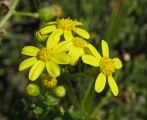 |
 |
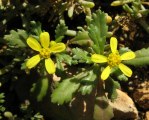 |
 |
IMAGE: SENLF-01 Photo of the bright yellow flowers borne as a corymb-like inflorescence that are produce from December to April. |
IMAGE: SENLF-02 Photo of the flowers that are formed in large numbers mostly around Feb-May. |
IMAGE: SENLF-03 Photo of 2 flowers which basically consists of a central disk with closely packed disk-florets, and a few ligules (petals) that are well spaced from each other. The number of ligules varies approximately between 5-8. |
IMAGE: SENLF-04 Photo of two flowers, where the upper one is the younger one since the blossomed disk florets are at the periphery, with the central one still closed in buds. The lower flower has no buds but all florets are in blossom. |
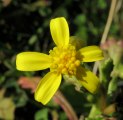 |
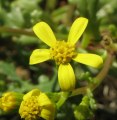 |
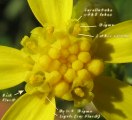 |
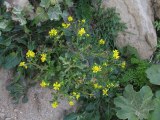 |
IMAGE: SENLF-05 Close up photo of the flower, showing the structure of the disk florets. Each floret is composed of a corolla tube with 5 lobes. The style protrudes out by 1-2mm, around which there is the anther collar, composed of 5 fused anthers that produces yolk-yellow pollen. |
IMAGE: SENLF-06 Photo of another flower showing well the structural details of the central disk florets. Every disk and ray floret produces one seed after getting fertilised. |
IMAGE: SENLF-07 Macro photo of the central disk with annotations describing the structural parts of the disk and ray florets. |
IMAGE: SENLF-08 Photo of flowering plant found in Dwejra in Jan 2007. |
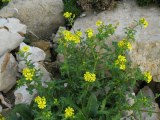 |
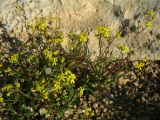 |
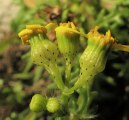 |
 |
IMAGE: SENLF-09 Photo of plant(s) with plenty of flowers. An interesting fact is that many flowers have 5 or 8 petals in Malta, wheras image sources on the internet show that they usually have more. For example in this specimen, most flowers have 8 petals, while in the next photo, the specimen has 5 petals. |
IMAGE: SENLF-10 Photo of plant specimen where many of the flowers have 5 petals. Compare with previous photo where the specimen has mostly 8-petalled flowers. |
IMAGE: SENLF-11 Photo of flowers (lateral view), showing the green, cup-shaped involucre made up of many, small, compact, bract-like structures called phyllaries arranged in 3-4 rows. Involucre is about 8mm long. Sometimes the phyllaries are called involucral bracts. |
IMAGE: SENLF-12 Photo of involucre. The lower row of phyllaries are triangular with a black tip. The phyllaries of the uppermost row are linear-oblong and about twice to thrice as long as those of the lower rows. |
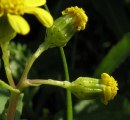 |
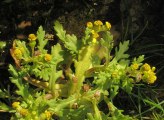 |
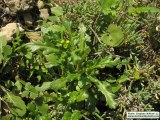 |
 |
IMAGE: SENLF-13 Photo of 2 involucres, held by pedicels about 15mm long. As the rest of the plant, the inflorescence is glabrous (hairless). |
IMAGE: SENLF-14 Photo of fleshy leaves which are produced in large numbers. They are coarsely pinnate or lobed with margins having large blunt teeth. |
IMAGE: SENLF-15 Photo of leaves showing their lobed structure. Adult leaves are more deeply lobed from the cauline ones. |
IMAGE: SENLF-16 Close up photo of leaves. In this photo one can note more their thick, succulent structure. |
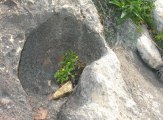 |
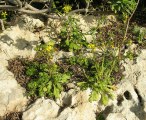 |
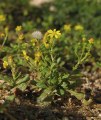 |
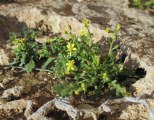 |
IMAGE: SENLF-17 Photo showing habit of this plant, that is garigue and rock gaps. The plant seems to prefer coastal areas, and is mostly found at the Southern and Western coastal areas of Gozo. |
IMAGE: SENLF-18 Photo of the low growing, erect plants on soil patches in rocks. |
IMAGE: SENLF-19 Photo of a small plant (lateral view) which as shown, branches at the lower part. |
IMAGE: SENLF-20 Photo of plants found at Dwejra, a site where this species is found frequently. |
 |
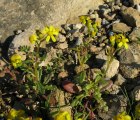 |
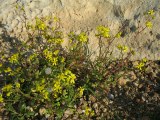 |
 |
IMAGE: SENLF-21 Photo of another plant that forms fleshy and lobed leaves and small, daisy-like, yellow flower heads (capitula). |
IMAGE: SENLF-22 Photo of 2 small plants growing in a rocky habitat. |
IMAGE: SENLF-23 Photo of a small population of plants mostly with flowers having 5-6 petals. |
IMAGE: SENLF-24 Photo of a mature plant showing its fleshy leaves and bright yellow flowers. |
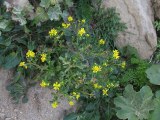 |
 |
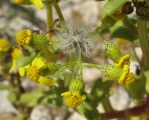 |
 |
IMAGE: SENLF-25 Photo of plant with flowers having 8 petals. As observed elsewhere in this profile, the number of petals seems to vary between 5-8 in Maltese specimen. |
IMAGE: SENLF-26 Photo of the fruit, a bristly ball made up of some 30-60 achenes (seeds) sitting on a common receptacle. |
IMAGE: SENLF-27 Photo of several flowers and a fruit. |
IMAGE: SENLF-28 Close up photo of the fruit, showing the individual seeds each having a simple pappus (set of bristles) which serves as a parachute to carry and disperse the seeds by wind. |
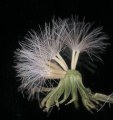 |
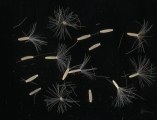 |
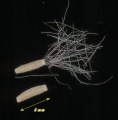 |
| IMAGE: SENLF-29 Scanned image of fruiting structure, showing few of the achenes attached to the receptacle. |
IMAGE: SENLF-30 Scanned image of seeds, some with the pappus removed. The pappus is beaklessand a simple one - just few whorls of unbranched bristles from the apex of the achene. |
IMAGE: SENLF-31 Magnified scanned image of 2 seeds (one without the pappus). The linear seed consists of several longitudinal ribs on which there is numerous, tiny, white hairs appressed down rather than spreading out. Bristles 3-4mm long. |
IMAGE: SENLF-32 |
|
| | |

